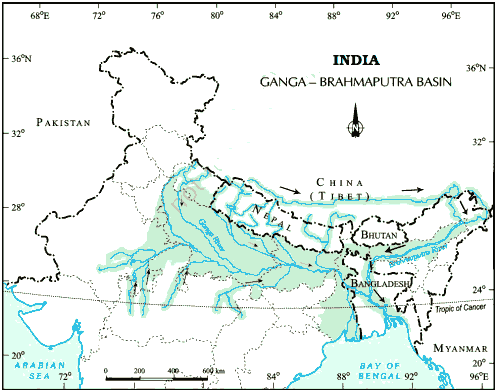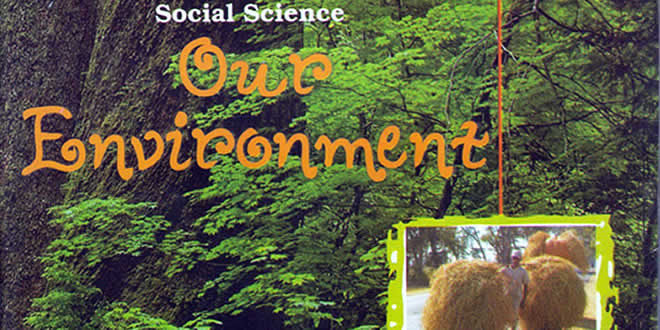Human Environment Interactions: The Tropical and the Subtropical Region – 7th Class Geography Chapter 08
Question: Why is Renuka excited?
Answer: Renuka is excited as her wildlife photographer uncle was coming back home. He had introduced her to the books having pictures of distant lands and life of people there.
Question: What are the similarities or differences between the people of different countries?
Answer: People of deserts, frozen land or hot wet forests only look different, they have same basic needs of food clothing and shelter. The children are all alike, they play same games, sing, dance, fight or make up. The main difference is that some of them live close to nature and have learnt to use and protect nature.
Life in the Amazon Basin
Question: Describe the situation and location of the Amazon Basin.
Answer: Situation and Location of the Amazon Basin:
- Look at the world map (on page 56 of the textbook), the Amazon Basin lies very close to the equator, between 10°N to 10°S.
- This region is known as the equatorial region.
- The river Amazon flows through this region.
It flows from the mountains in the west and reaches the Atlantic Ocean in the east.
- Numerous tributaries join in the Amazon river and they together form the Amazon Basin.
- The river basin drains portions of Brazil, parts of Peru, Bolivia, Ecuador, Columbia and a small part of Venezuela.
Human Environment Interactions – Question: Name the countries of the basin through which the equator passes. The countries of the basin through which the equator passes are:
South America:
- Ecuador
- Columbia
- Brazil
Africa:
- Gabon
- Democratic Republic of Congo
- Uganda
- Kenya
Asia:
- Indonesia
Question: What is river’s mouth?
Answer: The place where a river flows into another body of water is called the river’s mouth.
Question: Define the tributary.
Answer: The small rivers that join the main river are called its tributaries, for example Son, Yamuna are tributaries of Ganga.
Question: Give an account of the climate of Amazon Basin.
Answer: Climate of Amazon Basin:
- Amazon basin stretches directly on the Equator.
- It has hot and wet climate throughout the year.
- Both day and nights are almost equally hot and humid.
- Skin feels sticky.
- It rains almost every day.
- It rains without much warning.
- The day temperatures are high with high humidity.
- At night the temperature goes down but humidity is high.
Question: Give an account of rain forests and wild life of Amazon Basin.
Answer: Rain forests of Amazon Basin:
- In Amazon basin, it rains heavily.
- Thick forests grow here.
They are in fact so thick and dense that “roof” created by leaves and branches do not allow the sunlight to reach the ground.
- The ground remains dark and damp.
- Only shade tolerant vegetation grows here.
- Orchids, bromeliads grow as plant parasites.
Wild Life of Amazon Basin
- The rain forests are rich in fauna.
- Birds like toucans, humming birds, birds of paradise with their brilliantly coloured plumage, oversized bills for eating make them different from birds found in India.
- These birds also make loud sound in the forests.
- Animals like monkeys, sloth and ant-eating tapirs are found here.
- Various species of reptiles and snakes are also found in these jungles.
- Crocodiles, snakes, pythons abound.
- Anaconda and Boa constrictor are some of the species.
- Amazon basin is also the home of thousands of species of insects.
- Several species of fish like the flesh-eating Piranha fish is also found in the river.
- Amazon basin is actually extraordinarily rich in the variety of life found there.
Human Environment Interactions – Question: Describe the life of people of the Rain forests of “Amazon Basin”.
Answer: Life of the People of the Rain forests of Amazon Basin:
People grow most of their food in small areas after clearing some trees in the forest.
- Men hunt and catch fish along the rivers.
- Women take care of the crops.
- They mainly grow tapioca, pineapple and sweet potato.
- Hunting and fishing being uncertain, it is the women who keep their families alive by feeding them the vegetables they grow.
- They practise “slash and bum agriculture”.
- The staple food is manioc. It is also known as cassava. It grows under the ground like the potato.
- The people also eat queen ants and egg sacs.
- Cash crops like coffee, maize and cocoa are also grown in the Amazon Basin.
The rainforests provide a lot of wood for the houses.
- Some families live in thatched houses. They are shaped like beehives.
- There are other large apartment-like houses called “Maloca”. They have steeply slanting roofs to allow rain water flowing down easily.
Question: What changes have occurred with life of the people of Amazon Basin in recent times?
Answer: Life of the people of the Amazon basin is slowly changing.
In the early days, to reach the heart of the forest, river was the only means of transport.
- In modem times means of transport have developed considerably. In 1970 the Trans Amazon highway made all parts of the rain forest accessible.
- Aircraft and helicopters are also used for reaching various places.
- The aborigines (indigenous) population was pushed out.
- Diverse rain forests are being destroyed with long term consequences.
Question: What is the affect of Developmental activities in the Amazon basin?
Answer: The developmental activities are leading to the gradual destruction of the biologically diverse rain forests. Annually a large area is disappearing. The top soil is being washed away and the land is becoming barren.
Question: Give an account of Slash and Burn Agriculture.
Answer: Slash and Bum Agriculture:
- It is a way of cultivating land where farmers clear a piece of land by slashing or cutting down trees and bushes.
- These are then burnt, which release the nutrients into soil.
- New crops are grown in this cleared field for a few years.
After repeatedly using the patch of land, the soil loses its nutrients.
- So it is abandoned.
- Then they clear another plot of land to plant.
In the meantime young trees grow in the old field.
- In this way soil fertility is restarted (restored).
- People then return to it.
- They start cultivating again by repeating the process.
Life in the Ganga-Brahmaputra Basin
Question: Explain the physiography of the Ganga-Brahmaputra Basin.
Answer: Physiography of the Ganga-Brahmaputra Basin:
The tributaries of river Ganga and Brahmaputra together form the Ganga- Brahmaputra basin in the Indian subcontinent.
- It lies in the sub-tropical region.
- It is located between 10°N and 30°N latitudes.
The tributaries of the River Ganga like the Ghagra, the Son, the Chambal, the Gandak, the Kosi and the tributaries of Brahmaputra drain it.

Some of the tributaries of the river Brahmaputra are: Dihang, Dibang, Lohit and Dhansiri.
The main physiographical features of the Ganga-Brahmaputra Basin are:
- Mountains and foothills of the Himalayas
- Sundarbans delta
- Ox-bow lakes dot the plain area.
Question: River Brahmaputra is known. by different names in different places. It is called Tsangpo in Tibet. Find the other names of the river.
Answer: Dehang, Dahang, Jarnuna, Meghna, Padma etc.
Question: What is the climate of Ganga-Brahmaputra Basin?
Answer:
- The Ganga-Brahamputra Basin is dominated by monsoon climate.
- The monsoon brings rains from mid-June to mid-September.
- The summers are hot.
- The winters are cool and generally dry.
Human Environment Interactions – Question: Look at the Map of’ India. List the states in which the Ganga-Brahmaputra Basin lies.
Answer:
Ganga:
- Uttarakhand
- Uttar Pradesh
- Northern Madhya Pradesh
- Northern Chhattisgarh
- Bihar
- Jharkhand
- West Bengal
Brahmaputra:
- Arunachal Pradesh
- Assam
- Meghalaya
 Class Notes NCERT Solutions for CBSE Students
Class Notes NCERT Solutions for CBSE Students


